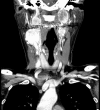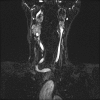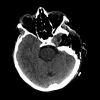What happens in vagus: a case of recurrent paraganglioma with malignant transformation and an updated treatment algorithm†
- PMID: 26858176
- PMCID: PMC4744899
- DOI: 10.1093/jscr/rjw012
What happens in vagus: a case of recurrent paraganglioma with malignant transformation and an updated treatment algorithm†
Abstract
Paragangliomas (PGLs) are rare, extra-adrenal tumors, originating from neural crest cells and can occur anywhere from the skull base to the pelvic floor. Although these tumors are often benign, a fraction of malignant cases exist. Few isolated cases of malignant head and neck PGL are reported in the literature. Treatment algorithms rely heavily on retrospective case studies and institutional experience. We report an unusual case of an extensive, hereditary PGL, with invasive characteristics, that was refractory to radiation therapy. An operative approach was selected for recurrent disease in the setting of critical neurovascular structure compromise. Six months postoperatively, the patient was recovering as expected and had no evidence of recurrent disease. We propose a modified treatment algorithm based on an updated literature review that encompasses the spectrum of PGL, from benign and asymptomatic to invasive and malignant disease.
Published by Oxford University Press and JSCR Publishing Ltd. All rights reserved. © The Author 2016.
Figures








References
-
- Mediouni A, Ammari S, Wassef M, Gimenez-Roqueplo AP, Laredo JD, Duet M et al. . Malignant head/neck paragangliomas: comparative study. Eur Ann Otorhinolaryngol Head Neck Dis 2014;131:159–66. - PubMed
-
- Wanna GB, Sweeney AD, Carlson ML, Latuska RF, Rivas A, Bennett ML et al. . Subtotal resection for management of large jugular paragangliomas with functional lower cranial nerves. Otolaryngol Head Neck Surg 2014;151:991–5. - PubMed
-
- Joshua AM, Ezzat S, Asa SL, Evans A, Broom R, Freeman M et al. . Rationale and evidence for sunitinib in the treatment of malignant paraganglioma/pheochromocytoma. J Clin Endocrinol Metab 2009;94:5–9. - PubMed
-
- Fruhmann J, Geigl JB, Konstantiniuk P, Cohnert TU. Paraganglioma of the carotid body: treatment strategy and SDH-gene mutations. Eur J Vasc Endovasc Surg 2013;45:431–6. - PubMed
-
- Patetsios P, Gable DR, Garrett WV, Lamont JP, Kuhn JA, Shutze WP et al. . Management of carotid body paragangliomas and review of a 30-year experience. Ann Vasc Surg 2002;16:331–8. - PubMed
Publication types
LinkOut - more resources
Full Text Sources
Other Literature Sources
Miscellaneous

